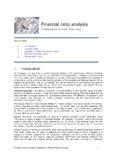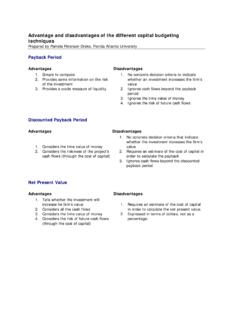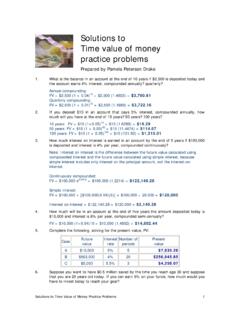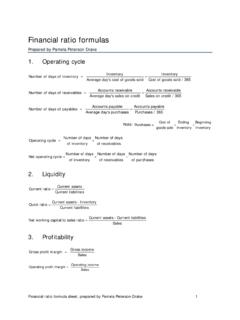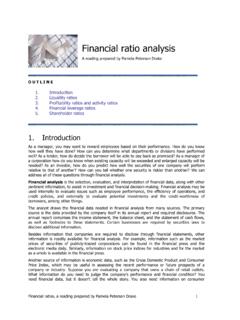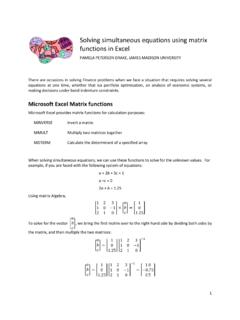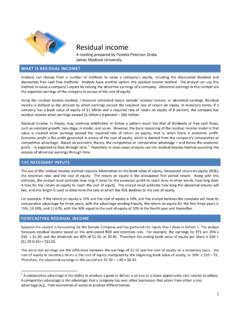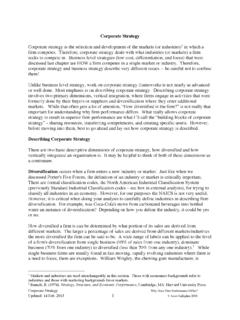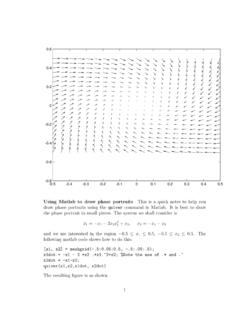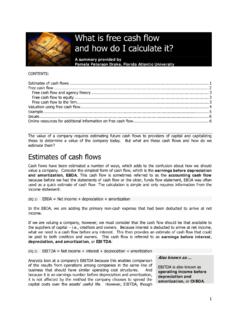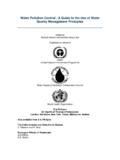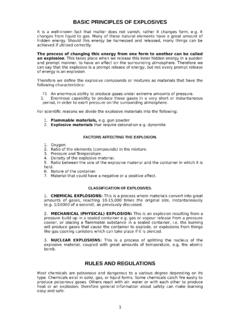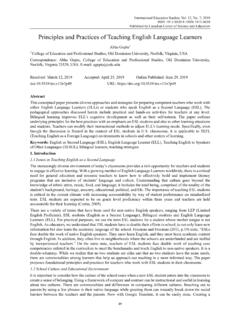Transcription of Cost of Capital - James Madison University
1 The cost of Capital A reading prepared by Pamela Peterson Drake OUTLINE. 1. 1. 2. Determining the proportions of each source of Capital that will be 3. 3. Estimating the marginal cost of each source of Capital .. 3. A. The cost of debt .. 3. B. The cost of preferred equity .. 4. C. The cost of common equity .. 5. 4. Calculating the weighted average cost of Capital .. 8. 5. Reality check .. 9. 6. 10. 1. Introduction The cost of Capital is the company's cost of using funds provided by creditors and shareholders. A. company's cost of Capital is the cost of its long-term sources of funds: debt, preferred equity, and common equity. And the cost of each source reflects the risk of the assets the company invests in. A. company that invests in assets having little risk in producing income will be able to bear lower costs of Capital than a company that invests in assets having a higher risk of producing income.
2 For example, a discount retail store has much less risk than an oil drilling company. Moreover, the cost of each source of funds reflects the hierarchy of the risk associated with its seniority over the other sources. For a given company, the cost of funds raised through debt is less than the cost of funds from preferred stock that, in turn, is less than the cost of funds from common stock. Why? Because creditors have a senior claim over assets and income relative to preferred shareholders, who have seniority over common shareholders. The cost of Capital , a reading prepared by Pamela Peterson Drake 1. If there are difficulties in meeting obligations, the creditors receive their Exhibit 1 case in point: The satisfaction of claims in the promised interest and principal before Eastern Airlines' bankruptcy and liquidation the preferred shareholders who, in In millions turn, receive their promised dividends Claim before the common shareholders.
3 If Claim type amount Payout the company is liquidated, the funds Secured debt with sufficient collateral $ $ from the sale of its assets are Secured debt with insufficient $ $ distributed first to debt-holders, then collateral to preferred shareholders, and then to Accrued interest on secured debt $ $ common shareholders (if any funds Unsecured debt $1, $ are left). An example of the Preferred stock $ Common stock $ $ possibility of insufficient funds to pay claimants is the case of Eastern Source: Lawrence A. Weiss and Karen H. Wruck, Information problems, airlines, which declared bankruptcy in conflicts of interest, and asset stripping: Chapter 11's failure in the case of Eastern Airlines, Journal of Financial Economics, Vol. 48, 1998, p 86. 1991, is shown in Exhibit 1. Eastern Airlines' secured creditors had collateral ( , security) sufficient to pay their claims; all other claimants did not receive their full claim on the assets of the company because there simply were insufficient funds available at the time the company liquidated.
4 For a given company, debt is less risky than preferred stock, which is less risky than common stock. Therefore, preferred shareholders require a greater return than the creditors and common shareholders require a greater return than preferred shareholders. Estiamting the cost of Capital requires us to first determine the cost of each source of Capital we expect the company to use, along with the relative amounts of each source of Capital we expect the company to raise. Then we can determine the marginal cost of raising additional Capital . We can do this in three steps, as shown in Exhibit 1. We look at each step in this reading. We first discuss how Exhibit 1: The cost of Capital to determine the proportion of each source of Capital to estimation process be used in our calculations. Then we calculate the cost of Step 1.
5 Each source. The proportions of each source must be Determine the proportions of each source determined before calculating the cost of each source of Capital that will be raised since the proportions may affect the costs of the sources of Capital . We then put together the cost and proportions of each source to calculate the company's Step 2. Estimate the marginal cost of marginal cost of Capital . We also demonstrate the each source of Capital calculations of the marginal cost of Capital for an actual company, showing just how much judgment and how many assumptions go into calculating the cost of Capital . Step 3. That is, we show that it's an estimate. Calculate the weighted average cost of Capital The cost of Capital for a company is the cost of raising an additional dollar of Capital ; therefore this cost is the company's marginal cost Capital .
6 Suppose that a company raises Capital in the following proportions: debt 40 percent, preferred stock 10 percent, and common stock 50 percent. This means an additional dollar of Capital is comprised of 40 of debt, 10 of preferred stock, and 50 of common stock. The cost of Capital , a reading prepared by Pamela Peterson Drake 2. 2. Determining the proportions of each source of Capital that will be raised Our goal as financial managers is to estimate the optimum proportions for our company to issue new Capital -- not just in the next period, but well beyond. If we assume that the company maintains the same Capital structure -- the mix of debt, preferred stock, and common stock -- throughout time, our task is simple. We just figure out the proportions of Capital the company has at present. If we look at the company's balance sheet, we can calculate the book value of its debt, its preferred stock, and its common stock.
7 With these three book values, we can calculate the proportion of debt, preferred stock, and common stock that the company has presently. We could even look at these proportions over time to get a better idea of the typical mix of debt, preferred stock and common stock. But are book values going to tell us what we want to know? Probably not. What we are trying to determine is the mix of Capital that the company considers appropriate. It is reasonable to assume that the financial manager recognizes that the book values of Capital are historical measures and looks instead at the market values of Capital . Therefore, we must obtain the market value of debt, preferred stock, and common stock. If the securities represented in a company's Capital are publicly-traded -- that is, listed on exchanges or traded in the over-the-counter market -- we can obtain market values.
8 If some Capital is privately placed, such as an entire debt issue that was bought by an insurance company or not actively traded, our job is tougher but not impossible. For example, if we know the interest, maturity value, and maturity of a bond that is not traded and the yield on similar risk bonds, we can get a rough estimate of the market value of that bond even though it is not traded. Once we determine the market value of debt, preferred stock, and common stock, we calculate the sum of the market values of each, and then figure out what proportion of this sum each source of Capital represents. But the mix of debt, preferred stock, and common stock that a company has now may not be the mix it intends to use in the future. So while we may use the present Capital structure as an approximation of the future, we really are interested in the company's analysis and resulting decision regarding its Capital structure in the future.
9 3. Estimating the marginal cost of each source of Capital A. The cost of debt The cost of debt is the cost associated with raising one more dollar by issuing debt. Suppose you borrow one dollar and promise to repay it in one year, plus pay $ to compensate the lender for the use of her money. Since Congress allows you to deduct from you income the interest you paid, how much does this dollar of debt really cost you? It depends on your marginal tax rate -- the tax rate on your next dollar of taxable income. Why the marginal tax rate? Because we are interested in seeing how the interest deduction changes your tax bill. We compare taxes with and without the interest deduction to demonstrate this. The cost of Capital , a reading prepared by Pamela Peterson Drake 3. Suppose that before considering interest expense you have $2 of taxable income subject to a tax rate of 40 percent.
10 Your taxes are $ Now suppose your interest expense reduces your taxable income by $ , reducing your taxes from $ x 40 percent = $ to $ x 40 percent = $ By deducting the $ interest expense, you have reduced your tax bill by $ You pay out the $ and get a benefit of $ In effect, the cost of your debt is not $ , but $ -- $ is the government's subsidy of your debt financing. We can generalize this benefit from the tax deductibility of interest. Let rd represent the cost of debt per year before considering the tax deductibility of interest, r*d represent the cost of debt Example 1: The cost of debt after considering tax deductibility of interest, and t be the Problem marginal tax rate. The effective cost of debt for a year is: Suppose the Plum Computer Company can issue debt with a yield of 6 percent. If Plum's marginal rd* = rd (1 - t) tax rate is 40 percent, what is its cost of debt?
